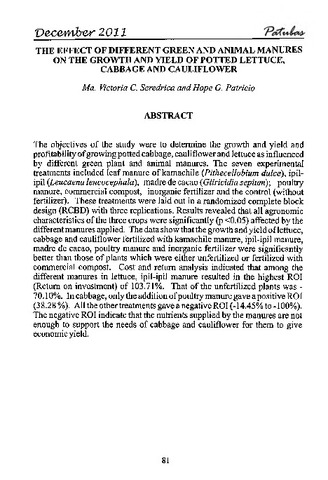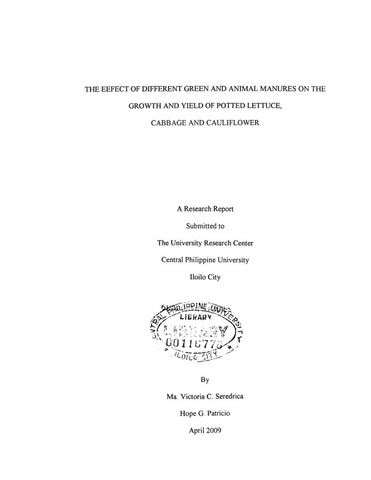The effect of different green and animal manures on the growth and yield of potted lettuce, cabbage and cauliflower
| dc.contributor.author | Seredrica, Ma. Victoria C. | |
| dc.contributor.author | Patricio, Hope G. | |
| dc.date.accessioned | 2021-03-22T02:46:43Z | |
| dc.date.available | 2021-03-22T02:46:43Z | |
| dc.date.issued | 2011-12 | |
| dc.identifier.citation | Seredrica, M. V. C. & Patricio, H. G. (2011). The effect of different green and animal manures on the growth and yield of potted lettuce, cabbage and cauliflower. Patubas, 6(1), 81-96. | en_US |
| dc.identifier.issn | 1908-515X | |
| dc.identifier.uri | https://hdl.handle.net/20.500.12852/629 | |
| dc.description | Journal article | en_US |
| dc.description.abstract | The objectives of the study were to determine the growth and yield and profitability of growing potted cabbage, cauliflower, and lettuce as influenced by different green plant and animal manures. The seven experimental treatments included leaf manure of kamachile (Pithecellobium dulce), ipil-ipil (Leucaena leucocephala), madre de cacao (Gliricidia sepium); poultry manure, commercial compost, inorganic fertilizer, and the control (without fertilizer). These treatments were laid out in a randomized complete block design (RCBD) with three replications. Results revealed that all agronomic characteristics of the three crops were significantly (p <0.05) affected by the different manures applied. The data show that the growth and yield of lettuce, cabbage, and cauliflower fertilized with kamachile manure, ipil-ipil manure, madre de cacao, poultry manure, and inorganic fertilizer were significantly better than those of plants which were either unfertilized or fertilized with commercial compost. Cost and return analysis indicated that among the different manures in lettuce, ipil-ipil manure resulted in the highest ROI (Return on investment) of 103.71%. That of the unfertilized plants was - 70.10%. In cabbage, only the addition of poultry manure gave a positive ROI (38.28 %). All the other treatments gave a negative ROI (-14.45% to -100%). The negative ROI indicates that the nutrients supplied by the manures are not enough to support the needs of cabbage and cauliflower for them to give economic yield. | en_US |
| dc.language.iso | en | en_US |
| dc.publisher | Central Philippine University | en_US |
| dc.rights | Attribution-NonCommercial-NoDerivs 3.0 Philippines | * |
| dc.rights.uri | http://creativecommons.org/licenses/by-nc-nd/3.0/ph/ | * |
| dc.subject.lcsh | Green manuring | en_US |
| dc.subject.lcsh | Green manure crops | en_US |
| dc.subject.lcsh | Fertilizers | en_US |
| dc.subject.lcsh | Cabbage | en_US |
| dc.subject.lcsh | Cauliflower | en_US |
| dc.subject.lcsh | Lettuce | en_US |
| dc.subject.lcsh | Lettuce--Fertilizers | en_US |
| dc.subject.lcsh | Cauliflower--Fertlizers | en_US |
| dc.subject.lcsh | Cabbage--Fertilizers | en_US |
| dc.subject.lcsh | Lead tree | en_US |
| dc.subject.lcsh | Manures | en_US |
| dc.subject.lcsh | Crop yields | en_US |
| dc.subject.lcsh | Growth (Plants) | en_US |
| dc.subject.lcsh | Organic fertilizers | en_US |
| dc.subject.lcsh | Urban gardening | en_US |
| dc.title | The effect of different green and animal manures on the growth and yield of potted lettuce, cabbage and cauliflower | en_US |
| dc.type | Article | en_US |
| dc.citation.firstpage | 81 | en_US |
| dc.citation.lastpage | 96 | en_US |
| dc.citation.journaltitle | Patubas | en_US |
| dc.citation.volume | 6 | en_US |
| dc.citation.issue | 1 | en_US |
| local.subject | Green manure | en_US |
| local.subject | Kamachile | en_US |
| local.subject | Ipil-ipil | en_US |
| local.subject | Madre de cacao | en_US |
| local.subject.scientificname | Brassica oleracea | en_US |
| local.subject.scientificname | Lactuca sativa | en_US |
| local.subject.scientificname | Brassica oleracea botrytis | en_US |
| local.subject.scientificname | Pithecellobium dulce | en_US |
| local.subject.scientificname | Leucaena leucocephala | en_US |
| local.subject.scientificname | Gliricidia sepium | en_US |
이 항목의 파일
This item appears in the following Collection(s)
-
Journal articles [25]
-
Patubas [110]
Patubas is a refereed research journal of Central Philippine University.






